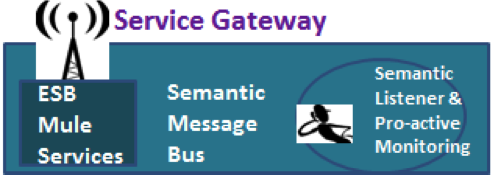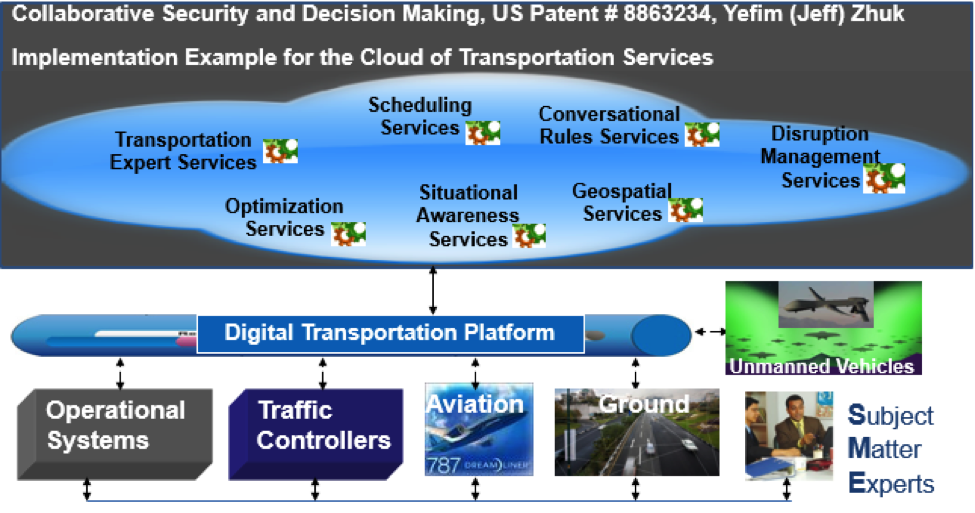Click to learn more about Yefim (Jeff) Zhuk. Catch up on this blog series with Part 1, Part 2, Part 3, and Part 4.
SOA and Microservices, RAML and DataSense by MuleSoft, and the Next Step
Semantic Logging and Semantic Listener
In a semantically rich environment, there is no need for complex monitoring tools. The service names and descriptions as well as application messages are self-explanatory and directly tied to the semantic execution model.
Application messages can describe as many properties as necessary with the idea that each property is defined in the semantic model. The messages can tell the story about WHEN (time), WHAT (description of the event), WHERE (system or/and service name), HOW Serious (type), HOW to fix (recovery action), and WHO should be notified.
A relatively simple semantic listener program can understand and act upon these messages.
This approach, when it is consistently used across the company and industry, will create smaller, smarter, and inexpensive semantic-sensitive tools to monitor and manage service operations. The same message will become a valuable record in the root cause analysis and recovery processes. Such records can be RDF-formatted. These RDF-formatted records-messages can represent the “situational awareness” factors.

Business Architecture Sandbox for Enterprise
The next step of software evolution offers new opportunities in many areas. One thing is clear: with the volume of information doubling every year, and with increasingly interconnected departments and corporations, semantic technology, the cool new kid on the block (who also happens to be pretty darn smart) is well on its way in.
In the future, new class called Knowledge Engineering and Semantic Cloud Architecture will be introduced in every school along with the subject of Critical Thinking. Modeling tools that have Business and Development views today will add an Ontology view tab to the front page. This is happening as you read these lines. The set of skills of the biggest demand is discussed in the review “Top Development Skills” (http://TopDevelopmentSkills.com) [12]. This review focuses on knowledge engineering as absolute necessity for moving to the next step of development – conversational modeling and manufacturing in partnership with computer programs. There are several programs in the country, including Internet Technology School [13] and Galvanize [14] currently teaching these subjects.

Semantic technology helps computers to better understand unstructured text, not just our commands. Then computer programs greatly increase their ability to partner with people on decision-making processes.
But stop dreaming of Artificial Intelligence. We are not there yet. Computers can help us more … when we can help computers. This is about a conversational approach, when a program is not necessary smart enough for complete understanding, but as a child can ask a clarifying question.
This is about a new generation of systems built with knowledge-driven architecture [4].
A good example would be adaptive robotic systems that can learn by conversing with people and store new skills as orchestrations of services.
A fundamental problem of current robotics is their limited set of skills that hard to expand. This is related to the current development methods that require multiple translations from natural language of task requirements to compiled and integrated working systems. Current robots are programmed to perform relatively simple, well defined and predictable tasks.
Adaptive robot system [6] with knowledge-driven architecture includes a built-in conversational mechanism to translate on-the fly changeable situational requirements into close to natural language but more precise terms. Each successful translation introduces another rule or even a situational scenario, adds a service, and increases the system power.
The integration of software and knowledge engineering is arriving on the scene in much the same way that object-oriented programming did when it replaced structural programming.
Similar to that time, the gap between the realities of the current enterprise and Semantic Cloud Architecture seems so huge that most companies are very cautious in approaching this cliff.
Business Architecture Sandbox for Enterprise (BASE) was designed to minimize this pain and to plant the seeds of Big Data and Semantic technology in the current business ground, enabling the next technology revolution.
BASE runs as a Web Application integrated with Mule, ESB [7] and Apache ActiveMQ [8]. This integrated system is configured as a cluster with multiple servers, providing high availability and failover.
BASE allows developers and subject matter experts describe and create business processes and workflows based on the REST API created on-the-fly on the top of business ontology.
These basic SOA standardizations provide the ground for service orchestration, reducing tight coupling of applications, and decreasing production problems and maintenance efforts.
To play with the prototype online just use the descriptions, the link and the key in the book online http://itofthefuture.com.
Collaboration of Services and Transformation of “tribal knowledge”
Collaboration between people and groups seems to be a thing with a positive sign, although we know how difficult this can be. Distributed knowledge and process systems [9] “allows involved parties, people and companies, negotiate multiple forms of collaboration online while sharing data and services.”
What is the need for collaboration of services?
Collaborative security of service groups is different from a single service security.
Simultaneous activity of many services, working on a common task, requires collaborative decision making. Think of a situation with multiple transportation services on the ground and in the air, when their interaction and collaboration is the must.

How can computer services optimize their behavior, when many of them simultaneosly perform different and sometimes conflicting tasks, interfere with external events and weather, trying to adapt to a quickly changing situation?
References:
- Cycorp combines an unparalleled common sense ontology and knowledge base with a powerful reasoning engine and natural language interfaces, http://cyc.com
- Financial Industry Business Ontology (FIBO) standard, http://www.edmcouncil.org/financialbusiness
- Conversational Semantic Service Map, Yefim (Jeff) Zhuk, The system for collaborative design, assembly on-the-fly, execution, benchmarking, and negotiation of computer services and applications by developers and subject matter experts, US Patent Pending.
- Knowledge-Driven Architecture, Yefim Zhuk, Streamlining development and driving applications with business rules & scenarios, US Patent, http://www.google.com/patents/US7774751
- The book online, “IT of the future”, http://ITofTheFuture.com, focuses on practical steps to transition the current IT of competing applications to a unified Semantic Cloud Architecture and describes Business Architecture Sandbox for Enterprise.
- Adaptive Robot System with Knowledge-Driven Architecture, Yefim Zhuk, On-the-fly translations of situational requirements into adaptive robot skills, US Patent, http://www.google.com/patents/US7966093
- MuleSoft Enterprise Service Buse (ESB), https://www.mulesoft.com/
- Apache ActiveMQ, http://activemq.apache.org/
- Distributed Knowledge and Process system, Yefim Zhuk, The system allows negotiate multiple forms of collaboration, and contains sufficiently flexible levels of data security for online collaboration, US Patent, http://www.google.com.sv/patents/US7032006
- Collaborative Security and Decision Making, Yefim Zhuk, transforming a beautiful idea of collaborative security decision making into a working system, US Patent,http://serviceconnect.org/
- Rules Collector system, Yefim Zhuk, Transforming “tribal knowledge” into formal rules to drive applications and business processes, US Patent, http://captureknowledge.org/
- Top Development Skills – review, http://topdevelopmentskills.com/TopDevelopmentSkills.pdf
- Internet Technology Summit Program – integrated software and knowledge engineering, http://InternetTechnology.us
- Galvanize IT – teaching Data Science, galvanize.com